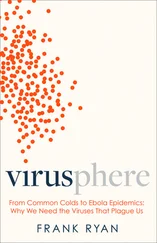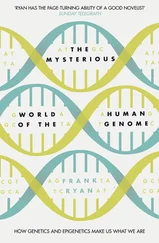What could cause viruses as terrifying as HIV-1 to change behaviour to this remarkable extent? This was a question guaranteed to fascinate me, so I made contact with Professor Essex, who was kind enough to agree to an interview with me.
By the spring of 1995, having digested the thinking of Terry Yates and Joshua Lederberg, and having interviewed many other leading virologists in the UK and Europe, from fields as diverse as botany, zoology and molecular biology, I was close to assembling what amounted to a jigsaw of understanding that came from adding the stories and views of these many experts into a single picture. By this stage I believed that our medical approach to the problem was inevitably skewed by our vocational, if entirely natural, concerns for humanity. Viruses had no such concerns. Thus, if I were to search for the evolutionary explanation for the emergence of plagues such as AIDS, I would have to abandon such vocational thinking, however deeply ingrained, and adopt a neutral stance that for me, as a doctor, felt curiously alien. I was obliged to ask myself this question: Is something very important going on in the world of plague viruses, something profound, which, if we could only grasp and define it, would give us a radically different perspective – a new level of understanding? So it was that, in February 1995, I made arrangements to return to America, where I planned to visit other experts at Harvard and Yale, and where I hoped to interview Essex among those based at Harvard. Unfortunately he was flying out of the country during the few weeks I would be in America, so I arranged a preliminary interview by phone two days before leaving England, to be followed up by a face-to-face meeting in the hustle and bustle of Washington National Airport.
Given my own earlier researches on the immune response to blood-borne viruses, I was very much looking forward to the prospect of talking to an investigator who shared my interest in immunity, and who had been a pioneer in linking animal and human retroviruses to the arrival of AIDS, and to the devastation of the immune system that gave rise to so many of its key symptoms and problems. During those heady years of fear and confusion, when AIDS was first challenging the world of medicine, he had also been one of the first to point to a retrovirus as the likely cause.
‘Why,’ I asked him, ‘had he become so involved with viruses?’
In fact, as he now explained to me, he had entered into a career in Veterinary Medicine because he was interested in viruses as a possible cause of chronic diseases, and cancer in particular. ‘At the time I was training, which was in the late 1960s, it was already clear that some forms of naturally occurring cancer were caused by viruses in animals, but it wasn’t yet clear in people, and there was debate about whether it would turn out to be true in people.’
We talked for a few more minutes about his earliest research, on diseases caused by retroviruses.
‘Two or three viruses were discovered in our laboratory during the time I was there, in either cats or monkeys, and it made a very solid case that long-term retroviruses – because they happened to be retroviruses – really could cause chronic diseases, such as leukaemias and certain other cancers. But then, as we were studying those parameters, we noticed that cats infected with these viruses developed a dramatic immunosuppression before they even developed cancer, and it even happened in the absence of developing cancer. Subsequently, it became clear that the immunosuppression was related to the strain of retrovirus … [This assumed a more societal importance when] it became clear that Gallo had identified the first human retrovirus.’ 3
The virus to which Essex was referring is now known as the human T-cell leukaemia virus, or HTLV-1, which causes T-cell leukaemia, a cancer involving the white blood cells known as lymphocytes, which play a key role in the body’s fight against viruses, and indeed against any form of foreign invasion of the blood or tissues. The story actually goes back to 1976, when a Japanese researcher, Dr Kiyoshi Takatsuki, was studying a newly discovered form of leukaemia, in which the cancerous cells had nuclei so dramatically convoluted that they looked like the bunched up petals of flowers. Takatsuki noticed that almost all of the sufferers came from Kyushu, a large island to the southwest of Japan, so he travelled to Kyushu where he found that doctors in the local hospitals were treating many people with this bizarre leukaemia. At this time nobody knew the cause of this disease, but they decided they would call it “Adult T-cell Leukaemia”. 4Then, in 1979, as Essex had just remarked, Robert Gallo and his collaborators at the US National Institutes of Health found the causative virus in the blood of a 28-year-old man from Alabama, who was suffering from a lymphoid cancer of his skin. Two years later, Japanese virologists Yorio Hinuma and Mitsuaki Yoshida isolated the same retrovirus from the Japanese leukaemia patients. This virus, which is now known as human T-cell leukaemia virus one, or HTLV-1, was the first human retrovirus to be isolated.
‘This was before AIDS was recognised?’ I asked Essex.
‘Before AIDS was recognised. It was probably about the time that, or shortly after, AIDS was already present in Americans but before it was recognised and appreciated as a clinical entity.’
We had arrived at what appeared to be a key moment in the early investigation of AIDS and I encouraged him to talk about it further.
‘There was a workshop in Seattle. It was contacted by our National Cancer Institute, in collaboration with the Japanese, to see how important such human retroviruses might be. I was invited to co-chair it … I went there with Gallo and about four or five people from his lab, together with six or seven Japanese investigators working on these viruses, such as Hinuma, Miyoshi, Yoshida and Takatsuki – the people who defined the leukaemia. It became clear during the discussion that there were lots of things that really needed to be done, and they just weren’t happening. The first thing I suggested doing – and was encouraged to do myself – was to question whether or not some of those viruses, like the human T-cell leukaemia virus, might be immunosuppressive, the way retroviruses of cats were, because they infected the same T-lymphocytes.’
‘Which immune cell in particular is infected by the HTLV-1 virus?’
‘The T4 lymphocyte – exactly the same cell as AIDS. It’s not absolutely clear that it’s through the same receptor, but it’s definitely the same cell. You find all the same transmission strategies, such as sex, and mother to infant, although HIV is a little more effectively transmitted cell-free by blood.’
Even today, HTLV-1 infection remains an important source of disease in Japan, America, in the Aborigines of Australia, Peru, Colombia, Ecuador, Africa and the Caribbean – and the Inuit of Northern Canada. As Essex explained, it is transmitted in the same way as AIDS, although the pattern of transmission varies from country to country. In Japan it is mainly transmitted from mother to child through breast-feeding, while in America, Australia and South America it is mainly through sexual intercourse and through contaminated needles, syringes and blood products. The disease pattern also resembles AIDS, with most of the deaths resulting from immunosuppression. A small percentage of sufferers get progressive nerve damage, and in the very long term it can cause cancers such as leukaemia and lymphoma. A closely related virus, HTLV-2, infects intravenous drug users in America and the Caribbean, which is also associated with nerve damage.
I listened attentively as Essex moved deeper into the heart of the preliminary investigation of the AIDS pandemic.
Читать дальше












